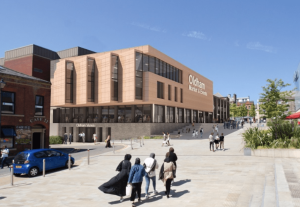Over a year on from the World Health Organisation (WHO) first announcing Covid-19 as a global pandemic and Prime Minister Boris Johnson addressing the nation on 23rd March 2020 with a message to ‘Stay Home, Protect the NHS and Save Lives,’ it is important to reflect on the impact that the virus and the national lockdowns have had on the construction industry and the UK in general.
In this article, with support from Summers-Inman and LSI architects, Key Account Manager Natalie Palframan examines the challenges and changes faced by the construction industry over the past year as we begin to return to a sense of normality and how Procure Partnerships is committed to helping public sector bodies bounce back.
A Reflection on Covid: One Year On
To date 127,087 people in the UK have died from Coronavirus, and 4,369,775 positive cases have been confirmed. We have endured two national lockdowns and have spent over 12 months living and working under Government restrictions. New measures for public safety were introduced, such as the mandatory requirement to wear a face mask, frequent hand sanitisation, a 2m social distancing rule and a work from home if you can order. Non-essential business was forced to close, having a hugely detrimental impact on the UK economy and industries such as retail, travel and tourism, and hospitality.
The increase in UK redundancy rates during the Covid-19 pandemic was higher than during the 2008-2009 economic downturn, increasing from 3.8 redundancies per 1,000 employees (0.38%) to 5.6 per 1,000 employees (0.56%). The administrative and support services industry had the highest redundancy rate in the period July to November 2020, at 35.8 per thousand employees. The Chancellor of the Exchequer, Rishi Sunak introduced the Government’s furlough scheme at the start of the first national lockdown to help companies pay 80% of the wages of staff who would otherwise have lost their jobs due to Covid-19. This was superseded by the Job Retention Scheme (JSS), with the key point of differentiation being that employers must genuinely plan to retain the employee(s). The Furlough scheme allowed all jobs to be retained to prevent an initial large influx of redundancies and uptake in Universal Credit claims at the start of the first lockdown.
On 22nd February Boris Johnson announced the UK’s roadmap out of lockdown, with a cautious and irreversible phased approach to lift restrictions, culminating in all restrictions expected to be removed from 21st June this year. This has been made possible by the first Covid-19 vaccine, Pfizer/BioNTech, announced on 2nd December 2020 as approved for the UK vaccination roll out programme, closely followed by the Oxford–AstraZeneca vaccine. To date over 32m people have received their first dose of the vaccine, and it is expected that all adults across the country will have been offered their first injection by the end of July.
How has Covid Impacted the Construction Industry?
The construction sector has quite a unique standing when it comes to assessing the response to the pandemic on business. In the main, construction was declared an essential industry, and so most projects were permitted to continue, even throughout the first national lockdown. However, the poor economic health of the country and the reduced public funding to support infrastructure projects was a major threat to project timeframes. As Government restrictions came into play to prevent the spread of the virus, the social distancing rules started to see an effect on production capacity, slowing down manufacturing productivity in the supply chain. The restrictions with travel across the borders also saw a backlog of imports for goods, restricting availability of supply for certain materials and forcing up the price.
The top three materials affected by the bottle neck of production were plasterboard, bricks, and mortar. There are very few UK manufacturers of plasterboard, and with the major manufacturer British Gypsum closed operationally during the first lockdown, this led to severe shortages, worsened by the fact that stocks were ringfenced for the build of the Nightingale Hospitals. Lead-times for bricks were high pre-pandemic, so when merchants were faced with a reduced workforce to operate safely, this exacerbated the situation, driving up the lead-times for production. Fundamental to many projects, particularly those in the residential space, supplies of mortar became increasingly limited. Major producers including CPI Mortars and Remix Dry Mortar closed, and therefore fell behind with supply to meet demand. The strain on the supply chain led to shortages and delays with essential materials needed to carry out works on construction sites, resulting in a frustrating stop-start situation, and in some cases the complete closure of sites.
Constructionline carried out a survey involving 4,292 suppliers and a staggering 87% responded that their business has been affected by the impacts of Covid-19, with 38% suffering significant financial difficulties as a result. 68% suspended operations with the top reason being that the main contractor had closed the site, followed closely by the project being placed on hold and a duty of care to protect the safety and wellbeing of staff. Interestingly only 8% planned to take up the Government’s Covid-19 Business Interruption Loan, whilst 49% took up the Government’s furlough scheme.
RICS (Registered Institute of Chartered Surveyors) in their survey of professionals across the UK, reported a decline in business with 80% seeing a decreased workload, 65% of construction projects were delayed with 47% of sites closed and 29% of projects cancelled; 69% experienced reduced cash flow, 49% were working from home rather than from an office location, 51% had been furloughed and 5% were made redundant.
So, with supply chain issues, many office-based teams working remotely, a skeleton workforce in some areas due to businesses utilising the furlough scheme and Government restrictions imposing new challenges to work safely on construction sites, what changes and measures have been implemented to make it possible for construction projects to continue?
David Andrews, Director, LSI architects, Commented: “As a practice we have faced many of the challenges that everyone in the industry will have faced, with work on site needing to be paused temporarily and with issues created around procurement.
Many projects that were placed on hold whilst the country responded to the pandemic are now back underway which has meant that as a practice we are busier than ever.
A real positive change that has come from this situation is that it has necessitated an acceleration in the number of people who have embraced technology like video conferencing and online collaboration tools such as ConceptBoard, who previously might have been hesitant.
We believe that this is helping to promote the open, collaborative environment that is critical to ensuring that the construction industry can become more efficient and meet the challenges that it faces, such as achieving net zero”.
Working Safely on Site During Covid
In December 2020, the Construction Leadership Council published the Site Operating Procedures (SOP) and Branch Operating Procedures, to offer guidance on adhering to the Government’s advice. The priority action points for early outbreak management were outlined as:
1. Complete a Covid-19 risk assessment.
2. Clean more often and wash hands regularly.
3. Remind visitors and staff to wear face coverings in any indoor spaces.
4. Make sure everyone adheres to social distancing and implement a one-way system where possible.
5. Provide adequate ventilation by ensuring a fresh flow of air to indoor spaces.
6. Take part in NHS Test & Trace by keeping a record of all staff and contractors for 21 days.
7. Do not allow anyone with Coronavirus symptoms to work.
Health and Safety procedures and risk management on site is even more critical to curtail the spread of the virus and to allow construction projects to progress whilst keeping the workforce safe. Equipment and machinery need to be manually cleaned to reduce contamination. Some sites have adopted HPV or UV-C technology, that can be used to thoroughly decontaminate construction sites by dispersing hydrogen peroxide vapour or ultraviolet light throughout the site, ensuring all areas are rapidly cleaned and any viral particles are eradicated. This method can completely decontaminate a site within minutes meaning that important work is not put on hold for long periods of time whilst decontamination takes place.
Sufficient PPE is essential. Initially there was a short supply of appropriate PPE as the healthcare industry were prioritised as they were subject to greater risk working in close proximity to patients who had contracted the virus. Pre-pandemic construction workers were used to wearing PPE such as steel toe capped boots, hard hats, protective goggles, and high-vis vests. Now workers must also have face masks, face coverings and where possible, gloves. Single-use PPE to avoid contamination means that sufficient stocks must be ensured.
As construction workers carry out their jobs in teams, the risk of spread and contamination is a lot higher than roles where tasks can be carried out independently or remotely, and therefore however challenging, these changes and adaptations to working practices on site remain critical to reduce exposure and risk.
David Blakey, Director, Summers Inman, Commented: “Of course, the coronavirus pandemic resulted in implications on current and future contracts. It is essential to proactively plan to address foreseeable consequences by engaging early with the client, professional team, contractor and supply chain to take the necessary steps to mitigate impact and delays. It is vital to work collaboratively, as a team, to de-risk the future by proactively planning for it – promote collaboration and a positive attitude
Working safely has always been a constant requirement and focus for all of our projects and COVID-19 has added to considerations in this respect. COVID related safety precautions will continue to be applicable into the near future and it is essential to follow and conform to current up to date guidance and Government advice.
Summers-Inman has always invested heavily into our connectivity. ICT infrastructure and systems are key to remote working and team communication. As a result of investment we have supported and maintained a constant high quality service provision to our clients throughout the pandemic.”
Will the Impacts of Covid for the Construction Sector be Permanent?
Currently the impacts of Covid-19 have seen many projects delayed or cancelled. The Constructionline survey indicated that Buyers could help get projects back on track by paying invoices on time, relaxing project deadlines, and agreeing to shorter payment terms. Whilst supply chain delays will begin to ease up as we ease out of Government restrictions, the temporary setbacks and delays may have longer lasting repercussions on cash flow. Procure Partnerships is committed to helping public sector bodies bounce back and get projects back on schedule. One way to achieve this is through our Direct call-off method. A framework contractor is directly selected for a project without re-opening competition. Contractors can work with you under a PCSA to develop any remaining design or request for your project to be fully priced.
It is likely that even with a successful vaccination programme, the extra health and safety precautions of face coverings, hand sanitisation and creating more space will have an on-going presence on site and within society in general. It is also expected that a larger proportion of contractors will allow more flexibility in the future for remote working where possible.
Click Here To Download a Procure Partnerships Framework User Guide
Twitter
Linkedin

Natalie Palframan, the Key Account Manager for the North of England at PPF, boasts nearly a decade of invaluable experience within the construction industry. In her dynamic role, Natalie has spent three impactful years at PPF, where her passion lies in closely collaborating with public sector clients across the North, providing expert advice and guidance for their projects.



